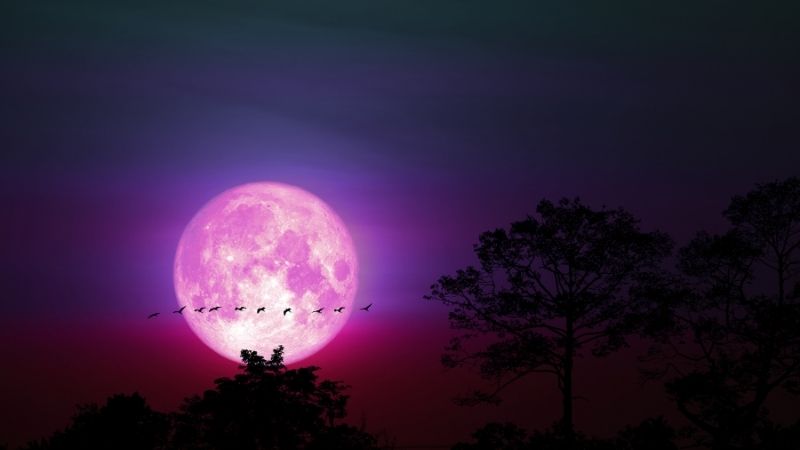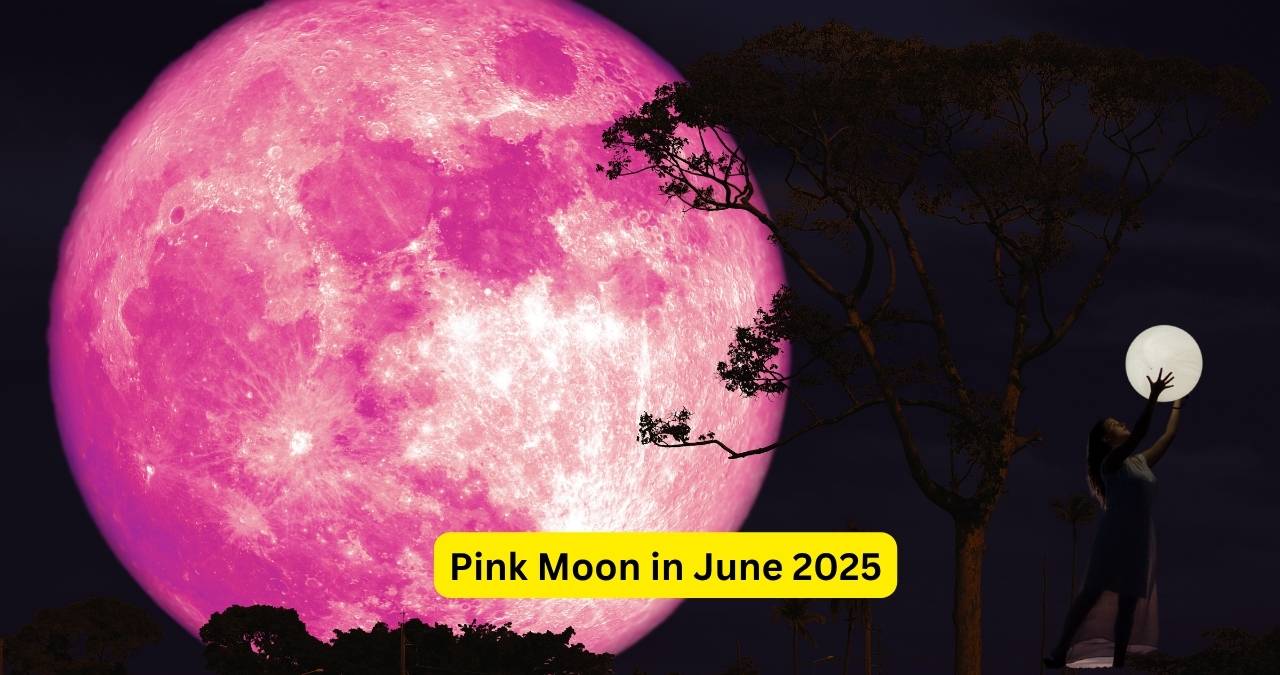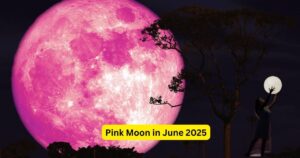Have you heard whispers about a pink moon tonight? If you’re searching for it on June 11, 2025, you might be in for a surprise. Tonight’s full moon isn’t the Pink Moon—it’s the Strawberry Moon 2025, and it’s one of the most spectacular lunar events of the year! Why? It’s the lowest full moon in nearly 20 years, a rare phenomenon that makes the moon appear larger and more vibrant. In this blog, we’ll clear up the confusion between the Pink Moon and the Strawberry Moon, dive into why this moon is so special, and share practical tips for observing and photographing it. Whether you’re a stargazer, a photographer, or just curious about the night sky, this guide will help you make the most of the Strawberry Moon 2025. Let’s get started!
Table of Contents
ToggleWhat Is the Strawberry Moon?
The Strawberry Moon is the full moon that graces the skies every June. It’s named by Native American tribes, like the Algonquian, Ojibwe, Dakota, and Lakota, to mark the strawberry harvest season in North America. Contrary to what some might expect, the moon doesn’t turn red or pink—it’s called the Strawberry Moon for its seasonal significance, not its color. However, when it’s low on the horizon, it can take on a warm, golden, or reddish hue due to atmospheric scattering, which might explain why some confuse it with a “pink moon.”
When to See It: The Strawberry Moon 2025 peaks on Wednesday, June 11, 2025, at 3:44 a.m. EDT (Astronomy.com).
Other Names: Depending on the culture, it’s also called the Rose Moon, Hot Moon, Mead Moon, or Green Corn Moon (Time and Date).
Fun Fact: The name reflects the time when wild strawberries ripen, signaling a time of abundance in nature.
This full moon is a celebration of summer’s arrival, and its unique position in 2025 makes it even more exciting.
Why Is It Called the Strawberry Moon?
The name “Strawberry Moon” comes from Native American traditions that tied lunar cycles to seasonal events. For tribes in North America, June was the time when wild strawberries began ripening, ready for harvest. These names were practical, helping communities track time and plan agricultural activities. The Maine Farmer’s Almanac popularized these names in the 1930s, preserving their cultural significance (Time and Date).
Cultural Variations:
The Arapaho called it “The Moon When the Buffalo Bellows,” reflecting the behavior of wildlife.
In Anglo-Saxon traditions, it’s known as the Honey Moon, possibly linked to the honey harvest or the tradition of June weddings.
Why It Matters: These names connect us to ancient practices, reminding us how humans have long used the moon to understand the world.
The Strawberry Moon 2025 carries this rich history, making it more than just a pretty sight in the sky.
The Science Behind the Lowest Full Moon in 20 Years
What sets the Strawberry Moon 2025 apart is its status as the lowest full moon in nearly 20 years, a rare event caused by a major lunar standstill. This phenomenon occurs every 18.6 years when the moon’s orbit reaches its maximum tilt relative to Earth’s equator, making it appear lower in the sky than usual. The next time this happens won’t be until 2043, so this is a once-in-a-generation event!
Understanding the Major Lunar Standstill
The moon’s orbit is tilted about 5.15 degrees relative to the ecliptic plane (Earth’s orbit around the Sun).
Combined with Earth’s axial tilt of 23.5 degrees, the moon can appear up to 28.65 degrees lower in the sky during a major lunar standstill.
In 2025, the Strawberry Moon will arc through Sagittarius, the lowest zodiacal constellation, keeping it close to the horizon (Astronomy.com).
Why Does It Look Bigger and More Colorful?
Moon Illusion: When the moon is near the horizon, it appears larger due to a psychological effect called the moon illusion, where the brain compares it to objects like trees or buildings.
Atmospheric Scattering: The moon’s light passes through more of Earth’s atmosphere when low, scattering shorter blue wavelengths and leaving reds and oranges, giving it a warm glow.
This unique positioning makes the Strawberry Moon 2025 a visual treat, perfect for both casual observers and avid photographers.
How to See the Strawberry Moon in 2025
Ready to witness the Strawberry Moon 2025? Here’s everything you need to know to catch this stunning event:

Best Viewing Times
Moonrise: The moon rises in the southeastern sky around 8:30 p.m. EDT on June 10, 2025, making this the ideal time to watch it climb above the horizon.
Peak Illumination: It reaches full brightness at 3:44 a.m. EDT on June 11, 2025, but it will look full all night (Astronomy.com).
Best Night: The evening of June 10 offers the best viewing as the moon rises during dusk, creating a dramatic backdrop.
Choosing the Perfect Spot
Clear Horizon: Find an open area like a field, hilltop, or beach with an unobstructed view of the eastern horizon.
Minimize Light Pollution: Rural areas or parks away from city lights are ideal for a clearer view.
Weather Check: Use the National Weather Service (weather.gov) to check for clear skies in your area.
Equipment for Viewing
Naked Eye: The Strawberry Moon is bright enough to enjoy without any tools.
Binoculars: A pair of binoculars (e.g., 7×50 or 10×50) can reveal craters and lunar maria (dark plains).
Telescope: For a closer look, a small telescope with a 50-100mm lens can show intricate lunar details.
Pro Tip
The moon is visible all night, so you can enjoy it at your convenience. Set an alarm for moonrise or check it out before bed—it’s a flexible show!
Cultural and Historical Significance of Full Moon Names
Full moon names are more than just labels; they’re a window into human history and culture. For centuries, people have used the moon to mark time, celebrate seasons, and guide their lives.
Native American Roots
The Maine Farmer’s Almanac popularized names like the Strawberry Moon and Pink Moon in the 1930s, drawing from Algonquian tribal traditions.
Each name reflects a seasonal event, like the Harvest Moon (September) for crop gathering or the Wolf Moon (January) for howling wolves.
Global Perspectives
Celtic Traditions: June’s full moon is often called the Rose Moon, symbolizing blooming roses.
Chinese Culture: The full moon is central to festivals like the Mid-Autumn Festival, though this occurs in September.
European Folklore: The Honey Moon ties to June’s association with weddings, possibly inspiring the term “honeymoon.”
Modern Uses
Today, full moon names are popular in astrology, spirituality, and social media, where they’re celebrated for their symbolic meanings. The Strawberry Moon 2025 connects us to these ancient traditions, reminding us of our shared history with the cosmos.
Clearing Up the Confusion: Pink Moon vs. Strawberry Moon
If you’re searching for a pink moon tonight, you’re not alone—there’s a lot of confusion out there! Let’s set the record straight:

What Is the Pink Moon?
The Pink Moon is April’s full moon, named after the pink wildflowers (phlox) that bloom in early spring.
In 2025, it occurred on April 12 at 8:22 p.m. EDT and is significant in Christianity as the Paschal Moon, which helps set the date for Easter (Almanac.com).
Why the Mix-Up with the Strawberry Moon?
Color Confusion: When any full moon is low on the horizon, it can appear orange or red, leading some to call it a “pink moon.”
Social Media Buzz: Recent X posts show this misunderstanding:
One user wrote, “the way it’s literally a pink full moon tonight whew” (X Post by dubbabyx).
Another said, “Tonight we’re witnessing the Pink Moon” (X Post by null_saga).
Generic Use: Some people use “pink moon” as a catch-all term for any striking full moon.
The Truth
Tonight’s moon is the Strawberry Moon 2025, not the Pink Moon. By understanding the difference, you can share accurate info and enjoy the correct lunar event!
10 Tips for Photographing the Strawberry Moon
Want to capture the Strawberry Moon 2025 in all its glory? Whether you’re using a smartphone or a DSLR, these tips will help you snap stunning photos:
Use a Telephoto Lens:
A lens with at least 200mm focal length is ideal for capturing lunar details. For close-ups, go for 400mm or more (Digital Camera World).
Stabilize Your Camera:
A tripod is essential to prevent camera shake, especially for long exposures (NASA Science).
Plan Your Shot:
Check moonrise and moonset times using tools like Time and Date (timeanddate.com).
Scout locations with a clear horizon and minimal light pollution, using apps like Google Maps.
Consider Moon Phases:
While the full moon is bright, crescent or gibbous phases can highlight lunar craters and shadows for more dramatic shots (Space.com).
Incorporate Landscapes:
Use a wider lens (50-100mm) to include the moon in a scenic landscape, like a city skyline or mountain range.
Experiment with Exposure:
The moon is bright, so use manual mode and bracket shots (try different shutter speeds and ISOs) to avoid overexposure.
Focus Manually:
Autofocus can struggle with the moon’s brightness. Use live view and manual focus for sharp images.
Use a Remote Shutter:
A remote shutter release or camera timer prevents shake when pressing the shutter button.
Go Advanced:
For detailed shots, use a teleconverter or a telescope with a camera adapter (Royal Museums Greenwich).
Post-Process Wisely:
Enhance contrast and sharpness in software like Lightroom or GIMP, but avoid over-editing to keep the moon natural.
Example
NASA photographer Bill Ingalls scouts locations days in advance to capture the moon with landmarks like the Washington Monument. For the Strawberry Moon 2025, try aligning the moon with a local landmark for a unique shot (NASA Science).
Conclusion: Don’t Miss the Strawberry Moon 2025!
The Strawberry Moon 2025 on June 11 is a rare and beautiful event, not to be confused with the Pink Moon. As the lowest full moon in nearly 20 years, it offers a unique opportunity to connect with the cosmos. Whether you’re marveling at its golden glow, learning about its cultural significance, or snapping photos to share on social media, this lunar event is a moment to cherish. So, grab your binoculars, find a clear spot, and let the Strawberry Moon 2025 light up your night. Have you seen it? Share your photos and experiences with us—let’s celebrate this celestial wonder together!
FAQs About the Strawberry Moon 2025
- Is the Strawberry Moon actually pink?
No, the Strawberry Moon 2025 isn’t pink. It’s named for the strawberry harvest, not its color. However, it may appear orange or red when low on the horizon due to atmospheric scattering.
- When is the next full moon after June 2025?
The next full moon after the Strawberry Moon 2025 is the Buck Moon on July 10, 2025 (Astronomy.com).
- Why is the 2025 Strawberry Moon the lowest in 20 years?
The major lunar standstill causes the moon to appear lower in the sky every 18.6 years. In 2025, this effect peaks, placing the moon in Sagittarius, the lowest zodiacal constellation.
- Can I see the Strawberry Moon from anywhere in the world?
Yes, the Strawberry Moon 2025 is visible anywhere it’s nighttime, weather permitting. Check local moonrise times for the best view.
- Do I need special equipment to see the Strawberry Moon?
No, you can enjoy it with the naked eye. Binoculars or a telescope can enhance details, and a camera with a telephoto lens is great for photos.
- What’s the best time to see the Strawberry Moon 2025?
The best time is at moonrise (around 8:30 p.m. EDT on June 10) when the moon appears large and colorful near the horizon.








